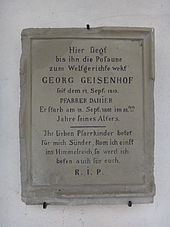Georg Geisenhof
Georg Maximilian Geisenhof OSB (born October 14, 1780 in Vils (city) , † September 18, 1861 in Unterkirchberg ) was a Benedictine monk of the former imperial abbey of Ochsenhausen . In 1829 he anonymously wrote a chronicle about the monastery Ochsenhausen, which was dissolved in 1803, under the title Brief history of the former imperial monastery Ochsenhausen in Swabia .
Life
Baptized in the name of Max Benedikt, Geisenhof grew up as the son of Josef Marian Geisenhof and Anna Maria Gutheinz in the small Ausserfern town of Vils . In 1799, under Abbot Romuald Weltin, he entered the Ochsenhausen Monastery in Upper Swabia, which at that time belonged to Upper Austria . He is listed as professor of philosophy and music teacher on the professions lists . After secularization in 1803, he continued his studies in Würzburg. From 1809 he was pastor and school inspector in Wiblingen . From 1819 he worked as a pastor in Unterkirchberg near Ulm, where he died and is buried in 1861 as the last conventual of the Ochsenhausen monastery.
timeline
Even one hundred and fifty years after its publication, his chronicle is considered the most comprehensive account of the history of the monastery. The small imperial state of God with its 255 square kilometers and 8,665 inhabitants and an annual income of 120,000 guilders took second place after the also Benedictine monastery Weingarten in Upper Swabia. The chronicle ends with gloomy words about the former powerful imperial monastery destined to wither:
But now everything is quiet and deserted. Soon the mighty destroyer - time - will encompass, break, and turn the magnificent palace into ruin.
However, his prognosis did not materialize - at least as far as the buildings are concerned: the monastery buildings shine in shine today, owned by the state of Baden-Württemberg as a state academy for young musicians .
plant
- Brief history of the former Ochsenhausen Imperial Monastery in Swabia . Ganser, Ottobeuren 1829 ( digitized version )
- Clergy in the Laupheim and Wiblingen country chapters. Obituary. Isele, Konstanz 2004.
literature
- Rupert Bader (Ed.): Carried through centuries. 600 years of the parish of Vils. Self-published, Vils 1994.
Web links
- Community chronicle of the city of Vils (PDF; 213 kB)
| personal data | |
|---|---|
| SURNAME | Geisenhof, Georg |
| ALTERNATIVE NAMES | Geisenhof, Max Benedikt (maiden name); Geisenhof, Georg Maximilian (full name) |
| BRIEF DESCRIPTION | German monk and author |
| DATE OF BIRTH | October 14, 1780 |
| PLACE OF BIRTH | Vils |
| DATE OF DEATH | September 18, 1861 |
| Place of death | Unterkirchberg |
